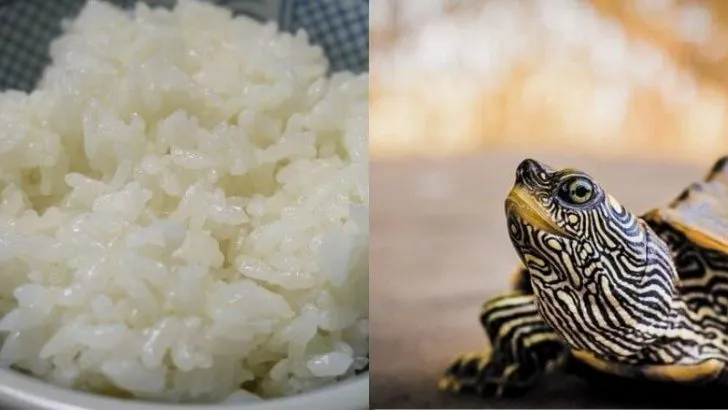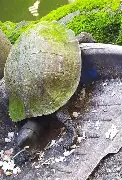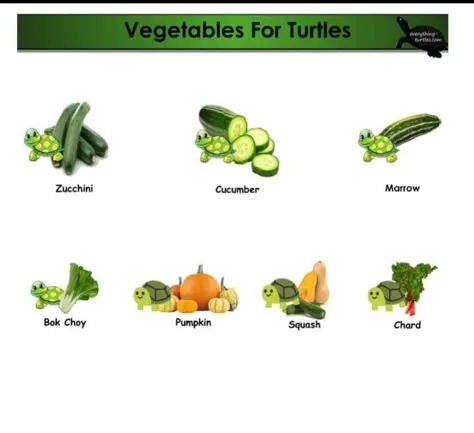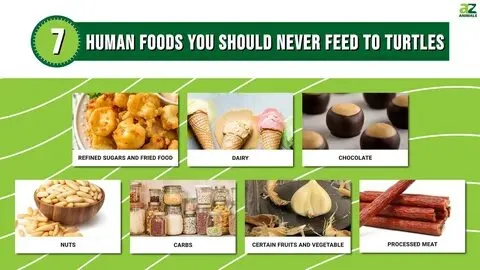
Can Turtles Eat Rice – Many turtle owners ask, can turtles eat rice? no, turtles should not eat rice. Their bodies are not made to digest grains, and rice can cause bloating, stomach problems, and poor nutrition. Turtles need natural foods like leafy greens, vegetables, and protein that keep them healthy and active. If you feed rice, your turtle may fill its stomach but will not get the nutrients it really needs.
This often leads to weak growth and health issues over time. So the problem is solved — rice is not safe for turtles. But here comes the real question: if not rice, then what should you feed instead to keep your turtle strong and happy? The complete guide below will show you the best safe foods and smart feeding tips every turtle owner must know.
Why Turtle Diet Matters
A turtle’s diet matters because it directly affects its health, growth, and lifespan. Just like humans, turtles need the right balance of vitamins, minerals, protein, and calcium to stay strong and active. If they eat the wrong foods, such as grains or processed items, they may suffer from weak shells, digestive problems, and low energy.
A proper diet keeps their shell hard, their body healthy, and their immune system strong. For pet owners, this means choosing natural foods like leafy greens, vegetables, fruits in moderation, and safe protein sources. By focusing on a balanced diet, you can prevent common health issues and give your turtle a longer, happier life.
Why Rice Is Unsafe for Turtles

1 Hard to Digest
Turtles cannot break down grains like rice, which leads to bloating and stomach discomfort.
2 Low Nutrition
Rice fills the belly but offers almost no vitamins, calcium, or protein that turtles need for growth.
3 Risk of Constipation
Cooked or uncooked rice can slow digestion and cause serious constipation in turtles.
4 Shell Weakness
Lack of proper nutrients in rice may weaken the shell over time and affect healthy development.
5 Not a Natural Food
Turtles do not eat rice in the wild, so it is unnatural and harmful when added to their diet.
Common Health Risks of Feeding Rice
Feeding rice to turtles may look harmless, but it can create serious health problems. Rice does not match their natural diet, and instead of giving strength, it often causes weakness and digestive issues. Below are the most common health risks turtles face when fed rice:
- Digestive Problems – Rice is hard for turtles to break down, leading to bloating and stomach pain.
- Constipation – Cooked or uncooked rice can block digestion and cause constipation.
- Poor Nutrition – Rice fills the stomach but does not give essential vitamins, minerals, or protein.
- Weak Shell Growth – Lack of calcium-rich foods in place of rice may result in soft or weak shells.
- Low Energy Levels – Without proper nutrients, turtles may become less active and weak.
Do Wild Turtles Eat Rice Naturally?
Wild turtles do not eat rice naturally because rice is not part of their habitat or diet in the wild. Instead, they eat foods that are easily available in nature such as plants, algae, insects, worms, and small fish. Their bodies are designed to digest these natural items, not processed or farmed grains like rice.
Even if wild turtles live near rice fields, they do not depend on rice as food, because it does not provide the nutrition they need. This shows that rice is unnatural and unsafe for turtles, whether wild or kept as pets.
Nutritional Needs of Pet Turtles
| Nutrient Group | Why It’s Needed | Best Food Sources |
| Protein | Essential for growth, strong muscles, and a healthy shell, especially in young turtles. | Commercial turtle pellets, insects (crickets, mealworms), small fish (guppies), and earthworms. |
| Fiber | Helps with good digestion and keeps the turtle’s stomach working smoothly. | Dark, leafy greens like kale, collard greens, and dandelion greens. |
| Vitamins (especially A) | Important for healthy eyes, skin, and a strong immune system. | Carrots, sweet potatoes, and high-quality commercial pellets. |
| Calcium | Crucial for a hard, healthy shell and strong bones. A lack of calcium can lead to a soft shell. | Calcium powder (dusted on food), cuttlebone, and dark leafy greens. |
| Water | Hydration is needed for all body functions and helps with digestion. | Fresh, clean water should always be available in their tank for drinking and swimming. |
| Fats | Provides energy and helps the body use some vitamins. It’s needed in small amounts. | Found naturally in commercial pellets and some of the protein sources like fish. Export to Sheets |
Safe Vegetables for Turtles

- Kale – Rich in calcium for strong shells.
- Collard Greens – Provides vitamins and minerals turtles need.
- Romaine Lettuce – A hydrating and safe leafy option (avoid iceberg).
- Dandelion Greens – Natural and full of nutrients.
- Mustard Greens – Supports healthy growth and digestion.
- Turnip Greens – Good source of calcium and fiber.
- Squash (zucchini, pumpkin) – Soft and easy for turtles to eat.
- Carrots (shredded or soft) – Adds vitamin A for eye and skin health.
Best Protein Sources for Turtles
A turtle’s diet needs a good amount of protein to stay healthy, especially for growth. Here are the best sources of protein for your pet turtle.
Also read must : Can Turtles Eat Parsley? Must Know Facts for Turtle Owners
1 Commercial Turtle Pellets
High-quality commercial pellets are a great base for their diet. They are made with a balanced mix of proteins, vitamins, and minerals specifically for turtles.
2 Insects and Worms
Live insects like crickets, mealworms, and earthworms are excellent. They provide not only protein but also a natural hunting experience that is good for your turtle’s mind and body.
3 Feeder Fish and Shrimp
Small, clean feeder fish like guppies or minnows are a fantastic source of protein. They also give your turtle exercise as it chases them, and shrimp are another easy and healthy option.
4 Cooked Chicken or Turkey
Lean, unseasoned, and cooked chicken or turkey can be given as a rare treat. It provides protein, but because it lacks a lot of other nutrients, it should only be a small part of their diet.
5 Aquatic Snails
Snails are a favorite for many turtles and provide a good source of protein and calcium. The shell of the snail is a natural source of calcium that helps keep your turtle’s shell strong and healthy.
Fruits Turtles Can Safely Eat
Here are some fruits that turtles can safely eat, but remember to feed them as a treat and not a main part of their diet. Fruits should be given in very small amounts because they are high in sugar.
- Apples: You can give small, thin slices of apple. Make sure to remove the seeds and the core, as they can be harmful.
- Bananas: A tiny piece of banana is a good treat. Because it’s so soft and full of sugar, only give it very rarely.
- Melon: Small cubes of watermelon, cantaloupe, or honeydew are safe. They are very watery and can be a nice, hydrating snack.
- Berries: Small berries like strawberries, blueberries, or raspberries are a favorite. You can cut them in half to make them easier for your turtle to eat.
- Grapes: A small grape, cut in half, is a safe treat. Always make sure to remove the seeds and skin if they are thick.
- Pears: You can give small, seedless pieces of pear. Make sure the fruit is ripe and easy to chew.
Also read must : Can Red Eared Turtles Eat Strawberries-Turtle Feeding Facts!
How to Create a Balanced Turtle Meal Plan
Creating a balanced meal plan for your turtle is crucial for their long-term health and happiness. It’s not just about what they eat, but also the right mix of food groups. Here’s a simple guide to follow:
1 Pellets as the Foundation
A high-quality commercial turtle pellet should make up about 25% of an adult turtle’s diet. These pellets are designed to provide a balanced base of protein, vitamins, and minerals.
2 Greens and Vegetables are Key
The largest part of a turtle’s diet, around 50-60%, should be fresh vegetables, especially dark, leafy greens. This provides essential vitamins and fiber.
3 Protein Sources for Growth
Protein should make up about 15-25% of their diet, especially for younger, growing turtles. Offer safe insects, worms, and small fish to meet this need.
4 Fruits as a Rare Treat
Fruits are high in sugar, so they should only be given as a small, occasional treat, making up no more than 10% of the total diet. Always chop them into small, manageable pieces.
5 Calcium and Vitamin Supplements
To ensure a strong shell and bones, you may need to add calcium and vitamin supplements to your turtle’s food. This is often done by “dusting” their food a few times a week, as recommended by a vet.
Foods You Should Never Feed Turtles

Some foods that are perfectly fine for humans can be very harmful to turtles. It’s important to know what to avoid to keep your pet healthy.
- Dairy Products: Turtles cannot digest milk, cheese, or other dairy. Giving them these foods can lead to severe stomach problems.
- Bread and Grains: Foods like bread, pasta, and rice swell up inside a turtle’s stomach. This can cause blockages and serious digestive issues.
- Salty or Processed Foods: Any food with added salt, sugar, or preservatives, like chips, crackers, or canned goods, is very bad for turtles and can cause long-term health problems.
- Sweets and Candy: Candy and sugary treats can make a turtle sick. Their bodies are not meant to process the high sugar content, which can harm their liver and other organs.
- Avocado: Avocado is toxic to many animals, including turtles. It can cause serious health issues and should never be fed to your pet.
- Dog or Cat Food: These foods are made for a different kind of animal and have a protein content that is too high for turtles. This can lead to kidney and liver problems over time.
- Wild Insects: While some insects are good, you should avoid giving your turtle insects from your yard. They might have pesticides on them or carry diseases.
Signs Your Turtle Has Digestive Problems
Having a sick pet is a real problem for a pet owner. A turtle’s health depends greatly on its diet. Knowing the signs of a digestive problem can help you act fast to help your turtle. Here are some of the most common signs:
- Changes in Appetite: If your turtle suddenly stops eating or eats much less than usual, it could be a sign of a blockage or stomach pain.
- Lack of Poop: A healthy turtle poops regularly. If you notice your turtle has not pooped in a day or two, it might be constipated or have a blockage.
- Swollen or Hard Belly: A turtle’s stomach should feel soft. If it feels hard or looks bloated, it could be a sign of gas, a blockage, or swelling from a bad food.
- Vomiting or Regurgitation: Seeing your turtle throw up its food is a clear sign that something is wrong. This can happen if it ate something it cannot digest.
- Lethargy and Weakness: A turtle that is unusually tired, lazy, and not moving much may be in pain from digestive issues.
- Strange-Looking Poop: If the turtle’s poop looks very different—like it’s very watery, has a bad smell, or has undigested food in it—this can mean there’s a problem with its diet or a digestive issue.
Faqs
What food is toxic to turtles?
You should never feed turtles human foods like bread, candy, and dairy products. They are also highly sensitive to foods like avocado, which is toxic, and things with a lot of salt, sugar, or preservatives.
What can turtles eat and not eat?
Turtles can safely eat a variety of foods, including leafy greens, some vegetables, and a mix of insects or worms for protein. They should not eat anything with added salt or sugar, dairy products, bread, or things that are difficult to digest like rice.
How many times do you feed a turtle in a day?
The frequency of feeding a turtle depends on its age. Younger turtles, or juveniles, should be fed once a day, while adult turtles (over two years old) can be fed every two or three days. The key is to provide a balanced diet and remove any uneaten food to keep their tank clean.
Do turtles need salt?
No, pet turtles do not need salt in their food or water. While sea turtles have evolved to handle salt in the ocean, freshwater and land turtles cannot, and too much salt can harm them by causing dehydration and other health issues.
What to add to turtle water?
For most pet turtles, the only thing you need to add to their water is a water conditioner. This is to remove chlorine and other harmful chemicals found in tap water, making it safe for your turtle to drink and live in.
Conclusion
When it comes to your turtle’s diet, the key takeaway is simple: stick to what’s natural. We’ve seen that rice is unsafe for turtles because their bodies cannot digest it. Feeding them rice can lead to serious problems like painful intestinal blockages and severe malnutrition, as it fills their stomach without providing any real nutrients. Instead of human foods like rice, a healthy meal plan should focus on a mix of high-quality commercial pellets, fresh vegetables, and safe proteins. By providing a balanced diet of leafy greens, insects, and occasional fruits, you’re not just feeding your pet—you’re giving them the best chance for a long, healthy life. Remember, a happy turtle is a well-fed turtle, and the best food comes from a place of knowledge, not from our dinner table.